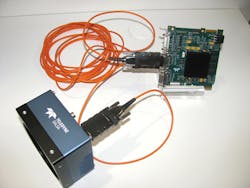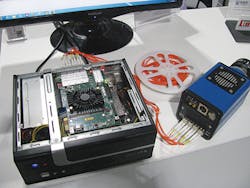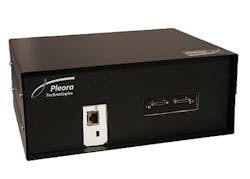Frame grabbers offer extended interface capabilities
Faster cameras, high-speed and emerging interface standards were on show at this year's Vision Show in Boston.
If there was one apparent trend at May's Vision Show in Boston, it was the disparate number of camera-to-computer interfaces that are now available to developers of machine vision systems. They range from GigE, through USB 3,0, Camera Link to CoaXPress (CXP) each of which have their own price/performance tradeoffs.
Today, the GigE standard, for example, allows data to be transferred at 1 Gigabit/s using low-cost, Ethernet cables. More established standards such as Camera Link that are available in Base (255 MBytes/s), Medium (510 Mbytes/s), Full (680Mbytes/s), and Extended-Full configurations (850 MBytes/s) allow camera-to-computer distances of up to 10m (without repeaters) and use more expensive Camera Link cables. Other, faster implementations such as the CoaXPress (CXP) standard allow data rates of up to 6.25Gbits/s per channel also using Coax cables to achieve long camera to cable connections.
Established standards
While established standards such as Camera Link have been offered for more than 15 years, PCI frame grabbers for the interface are becoming smaller and less expensive. At the Vision Show, for example, Chris Beynon, Chief Technical Officer at Active Silicon (Iver, England, UK; www.activesilicon.com) showed two of the latest additions to the company's line-up of Camera Link frame grabbers.
The first, the FireBird Camera Link Deca frame grabber (1xCLD-2PE4) has a 4-lane Gen2 PCI Express interface and supports Version 2.0 of the Camera Link specification, including both 80 bit modes: 8 bit 10-tap and 10 bit 8-tap modes (Camera Link Deca) at clock rates up to 85 MHz (Figure 1a). The FireBird can capture data from two simultaneous Base Camera Link cameras and single Base, Medium and Full configurations. The second, the 1xCLD-2PE4L is a low-profile design that allows the frame grabber to be used in small embedded PC enclosures and rack-mount cases where full height PC cards are not suitable (Figure 1b).
While many manufacturers produce frame grabbers for the Camera Link standard, the standard's high-speed version Camera Link HS (CLHS) has been endorsed by companies such as Matrox Imaging (Dorval, QC, Canada; www.matrox.com), Teledyne DALSA (Waterloo, ON, Canada; www.teledynedalsa.com) and Silicon Software (Mannheim, Germany, https://silicon.software) all of which released CLHS frame grabbers at VISION 2014 in Stuttgart, Germany.
IP Cores
Two IP cores are available from the AIA (Ann Arbor, MI, USA; www.visiononline.org) that support each of the physical layer implementations of the Camera Link HS standard. While the M core currently supports 3.125 Gbits/s per lane, the X protocol supports speeds of 10.3 Gbits/s per lane. Using a single CX4 copper cable, up to seven data lanes and one command channel is supported by the M core while a single data lane and command channel is available when using an SFP+ connection. While the X protocol currently specifies the use of a SFP+ connector resulting in a single bidirectional channel of 10.3Gbps, using a Quad Small Form-factor Pluggable (QSFP) connector will enable X protocol Camera Link HS systems to support four channels of data, allowing a fourfold data throughput over a single fiber cable.
While the CX4 connector can be used to transfer data over copper cable, Teledyne DALSA showed how the latest CX4 active optical cable from Alysium (Nuremberg, Germany; www.alysium.com) could be used to extend the camera-to-computer distances of CLHS M implementations. At Teledyne DALSA's booth, the company showed a member of its Pirahna XL line of CMOS TDI cameras interfaced to the company's Xtium-CLHS PX4, a PCI Express Gen 2.0- based frame grabber (Figure 2) using the CX4 active optical cable.
Up until this year's Vision show, no company - not even Teledyne DALSA - had offered a CLHS frame grabber based around the X protocol. However, at the show, Kaya Instruments (Haifa, Israel; www.kayainstruments.com) demonstrated the world's first such frame grabber, the Komodo-CLHS. Supporting the Camera Link HS X Protocol (10G) standard, the board is capable of receiving data from up to eight CLHS X Protocol links using four SFP+ 10GigE transceivers and a single QSFP+ 40GigE optical interface. Each link supports standard X Protocol bitrates up to 10Gbps. The board's eight-lane Gen 3.0 PCI Express interface allows data transfer between optical links and computer memory.
At the Vision Show, Michael Yampolsky, Chief Executive Officer of Kaya Instruments demonstrated how the board could be used to interface to the pco.flow camera from PCO (Kelheim, Germany; www.pco.de). With a 4096 x 3072 CMOS imager running at 335 fps (in 8-bit/pixel mode), the camera uses four CLHS (10G) links to transfer data at a rate of up to 4.4GBytes/s to the frame grabber. To do so, the camera features four SFP 10 Gig fiber-optic transceivers that are in turn interfaced to four 10Gig transceivers on the Komodo frame grabber (Figure 3). This allows camera to computer distances of up to 10km to be achieved.
Like the CLHS standard, the CXP standard has also been adopted by frame grabber vendors looking to support the next generation of high-speed cameras. Currently, the CXP standard allows a single coaxial cable to provide up to 6.25Gbps image data and camera power and control signals between the frame grabber and camera at distances of < 50m at these data rates and 100m at 3.125Gbps. To increase this speed, multiple cables can be used (see "Cabling choices for camera interfaces," Vision Systems Design, September 2015, http://bit.ly/1U2oTrJ).
According to some vendors of such products, it may be likely that at the Vision 2016 tradeshow in Stuttgart, Germany in November, CXP frame grabbers may be demonstrated that support speeds of 10Gbps (CXP-10) and 12.5Gbps (CXP-12).
Networking standards
While such high-speed interfaces are more expensive than lower-speed interfaces such as GigE and USB 3, companies such as Pleora (Kanata, ON, Canada; www.pleora.com) are looking to reduce the cost of designing high-speed imaging systems by developing interfaces that will use emerging networking standards to allow such cameras to transmit GigE Vision compliant data over NBASE-T.
"Rising bandwidth requirements for mobile devices had led to a demand for network-access speeds of 2.5 Gbps and 5 Gbps," says John Phillips Sr. Manager, Product Management with Pleora. "Because of this, companies such as Aquantia (San Jose, CA, USA; www.aquantia.com), Cisco (San Jose, CA, USA; www.cisco.com), Freescale Semiconductor - now part of NXP Semiconductors (Eindhoven, The Netherlands, www.nxp.com) and Xilinx (San Jose, CA, USA; www.xilinx.com) founded the NBASE-T Alliance (Beaverton, OR , USA; www.nbaset.org) to define the 2.5GBASE-T/5GBASE-T Ethernet standard that allows speeds of 2.5 and 5Gbit/s at up to 100m to be transmitted over Ethernet cable."
Leveraging this standard in the development of its prototype Camera Link to NBASE-T converter, Pleora has designed a system that allows data from Camera Link Medium cameras to be transmitted using the GigE Vision standard at up to 100m over CAT-5e Ethernet cables (Figure 4).
At the Vision Show, the company demonstrated the system interfaced to a Bobcat Camera Link Medium camera from Imperx (Boca Raton, FL, USA; www.imperx.com). In the design of the system, digital data from the camera is first interfaced to an Artix-7 FPGA from Xilinx. By using the device's transceivers, data is then transferred to an Aquantia AQR105 single port PHY that allows speeds of 5Gbit/s to be achieved, faster than the Camera Link Medium data rate. Output from the PHY is then accessible through a standard RJ45 connector.
While the technology demonstrator system shown at the show was packaged as a system, Pleora intends to introduce a low-cost GigE Vision over NBASE-T development kit for approximately $2,000. "With this," says Phillips, "third-party vendors will be able to evaluate the system and either implement Camera Link to NBASE-T converters as stand-alone devices or purchase the reference design and integrate the technology directly into their cameras. This will allow developers of Camera Link systems to extend the range of the camera to computer distances to 100m while supporting data rates as fast as 510MBytes/s."
Recent frame grabber introductions
Video board for embedded imaging
Featuring a DM8168 900 MHz DSP for video processing, the nVision GX3 is a multi-format intelligent video acquisition device for mobile or remote capture. The GX3 features a 1.2GHz ARM Cortex - A8 with Linux OS, two independent video input channels, HDTV input supporting up to 1080p60, and H.264 video encoding and decoding. Additionally, the GX3 has 10/100/1000 Ethernet, general purpose I/O triggers, USB 2.0 interface, 1GByte flash memory, 2GByte DDR3 frame buffer, SD memory card interface, and dual UART serial communications. dPict Imaging (Indianapolis, IN, USA; www.dpictimaging.com)
Support for CXP added to PCIe/104
The Coaxlink Duo PCIe/104 is a stackable card compliant with the PCIe/104 form factor. The board features two CoaXPress CXP-6 connections with 1,250 MB/s camera bandwidth and a PCIe 2.0 (Gen 2) x4 bus with 1,700MBytes/s. The company has also announced the Coaxlink Quad G3 DF, a CXP frame grabber with four CXP-6 inputs and four CXP-6 data forwarding outputs. The frame grabber enables users to share the data coming from the camera between two or more host computers, Euresys (Angleur, Belgium; www.euresys.com).
Camera interfaces get smaller
Featuring a 2 x 1.18in size, the PIXCI EB1miniH frame grabber is available in full and half-length versions, and features a Base Camera Link connector and runs the company's XCAP imaging software. XCAP supports ARM processors, Windows and Linux support for I386 and X86_64 Intel processors. EPIX Inc. (Buffalo Grove, IL; www.epixinc.com).
Companies mentioned
Active Silicon
Iver, England, UK
www.activesilicon.com
Alysium
Nuremberg, Germany
www.alysium.com
Aquantia
San Jose, CA, USA
www.aquantia.com
Cisco
San Jose, CA, USA
www.cisco.com
Teledyne DALSA
Waterloo, ON, Canada
www.teledynedalsa.com
Imperx
Boca Raton, FL, USA
www.imperx.com
Kaya Instruments
Haifa, Israel
www.kayainstruments.com
Matrox Imaging
Dorval, QC, Canada
www.matrox.com)
Silicon Software
Mannheim, Germany
https://silicon.software
NBASE-T Alliance
Beaverton, OR, USA
www.nbaset.org
NXP Semiconductors
Eindhoven, The Netherlands
www.nxp.com
Pleora
Kanata, ON, Canada
www.pleora.com
PCO
Kelheim, Germany
www.pco.de
Silicon Software
Mannheim, Germany
https://silicon.software
Xilinx
San Jose, CA, USA
www.xilinx.com
For more information about frame grabber companies and products, visit Vision Systems Design's Buyer's Guide buyersguide.vision-systems.com
About the Author

Andy Wilson
Founding Editor
Founding editor of Vision Systems Design. Industry authority and author of thousands of technical articles on image processing, machine vision, and computer science.
B.Sc., Warwick University
Tel: 603-891-9115
Fax: 603-891-9297




